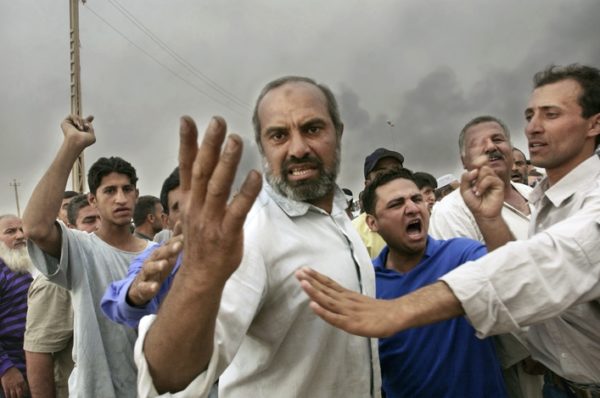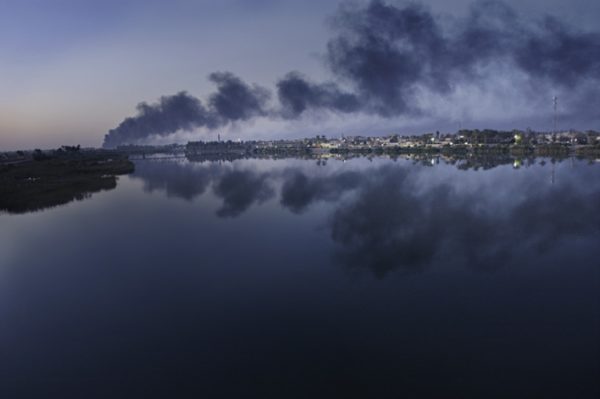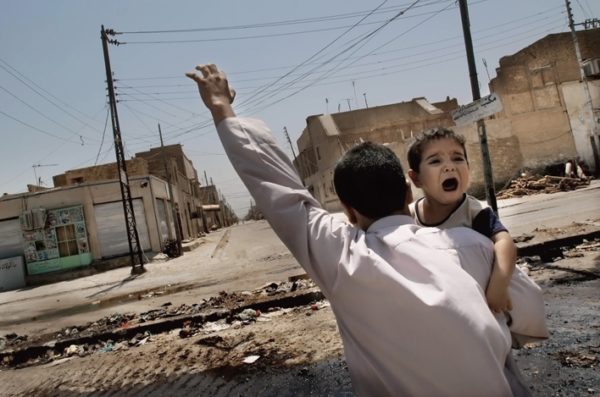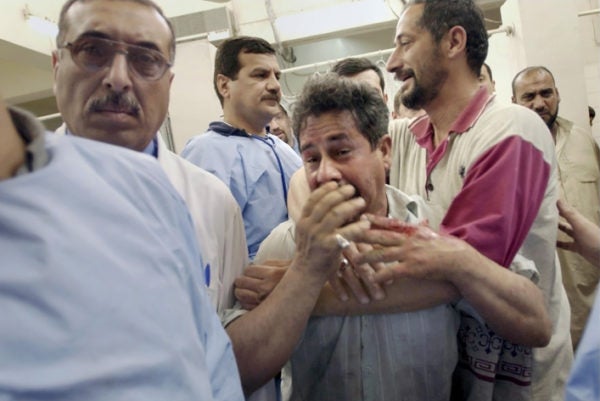
I met Kael Alford while at graduate school at Savannah College of Art and Design Atlanta. I was lucky enough to have her as a professor for Documentary I, where I learned the difference between, and similarity of, documentary and fine art photography. Unfortunately, Kael only stayed a year in Atlanta because she was called away after receiving a Nieman Fellowship at Harvard in 2008-2009. Since then she’s continued to teach at Southern Methodist University in Dallas, Texas though she’s kept her connections strong to the Southeast, particularly Atlanta. She recently found a home for her work at the Jennifer Schwartz Gallery, and next year Alford will participate in the High Museum’s Picturing the South series during the summer of 2012. Kael will be traveling back to Iraq after seven years to revisit her work from Unembedded, a documentary project focusing on Iraqi civilian life. Before she left for her trip, I had the chance to ask her a few questions.
Ryan Nabulsi: You’ve traveled to many different places, interacted with different cultures and all types of individuals; when thinking about photographing a story, are you more interested in the place or the people?
Kael Alford: It’s usually the situation that draws me, or more specifically, the particular moment in history of a place. Like the basis of a good novel, it’s the conflicts of humanity that help us understand ourselves. I’m interested in how people struggle to live with their differences, which is why I’ve been drawn to document various kinds of conflict. We can be humane and civil most of the time, so we tend to forget that we’re also animals. We just happen to have large, slightly more reasonable brains.
In the Balkans for example, and in Iraq during the sectarian violence there, and during the American Civil War, neighbors and families, who lived more or less peacefully for generations, became fearful and mistrusting of each other until slaughtering one another seemed like a logical thing to do. It’s a terrifying process to witness, but we need to understand it. When I started this work, I was seeking that understanding. Now I cast a broader net and look for much quieter, less obvious dramas too, but there is always some underlying tension or conflict in what interests me.

RN: When I think of a photojournalist, I’ll be honest, you would not be the first person I would peg to have gone unembedded into Iraq, when traveling in unstable areas, did you find your appearance to be a disadvantage or an advantage?
KA: Being a fairly small framed woman (if that’s what you mean?) is mostly an advantage, I think. I have cleaned up a lot recently, so I fit in a bit better here in the U.S. now too! It’s true everywhere—I try to blend in. I like to be an observer and that way people are less suspicious of me hanging around. Women are generally seen as less threatening then men anyway, and this can be a great advantage. And being a foreigner can help too. I get to bend rules that locals have to follow.
RN: You’re going back to Iraq soon, why? What are you interested in investigating on your return trip? And do you have any leads or contacts when you get there?
KA: There are many reasons to return to Iraq. I was first in Iraq in 2003 -2004, before, during, and after the U.S. invasion. I’ve always expected to return and I thought if I waited much longer, it would only get harder to go. I received money from the Knight Luce Foundation for Global Reporting to finance the project I proposed, so that meant I could set my own parameters without being beholden to assignment work alone.
Timing wise, most combat troops have pulled out of Iraq now and more are scheduled to leave by the end of this year based on a security agreement with the Iraqi government. This made the visit somewhat timely, which is important if you want news-type outlets to publish your work.
In the broad sense, I’ll investigate the legacy of the U.S. invasion and the aftermath of a horrific civil war. Iraq is barely in the U.S. news any longer, but the complex ties between our countries, for better or worse, are now a part of our permanent records. This is true for me personally as well. It’s a place I think about almost daily. I’ve spent the last months tracking down the people I knew there. I’ve re-established some contact with Iraqi civilians, drivers, translators, and friends. I’m going to revisit them and see what is happening in their lives now and how the U.S. invasion has affected them. I’d like to see if the sectarian divisions in the country have changed how people think, live, or identify themselves. I’ll also be traveling with photographs that I made on my previous trips, using them as a means to find subjects whose names I never even knew, in some cases.
A lot of terrible things have happened since I left—just unthinkable violence. It’s going to be a sad trip in some ways, with some very bright spots. I’m excited about finding the people who were so open and kind with me even when our countries were at war. I feel like I owe it to them, the people who let me in, not to forget them. I think it’s largely those people giving me the nerve to return. So this feels like a personal journey as much as a photographic or journalistic mission.

RN: After traveling to shoot a story, how long does it take for you to get reacquainted with ‘real life?’ Do you work on multiple stories at once, or one at a time?
KA: I’ve come up with a formula that seems to describe it for me: for every week I am away working on a long-term project, it takes about a week to fully return home—particularly after a long trip. I’m immersed when working on a project and the rest of the world sort of slips away. Relationships at home might change in that time, you lose track of the news of your family and friends. So if your life is lived on the road half the time or more, you are never quite home, you’re always moving emotionally as well as physically. Some people only feel at home when on the road. It’s a strange existence that many photojournalists live; it’s like existing in multiple, parallel universes. ‘Real life,’ of course, is wherever you are. There are multiple realities in the world and photojournalists get to move in and out of those realities.
There is nothing like the process of becoming comfortable in a new place as the curtains of mystery are lifted. You’re on high alert, always scanning for images and meaning with all of your senses. I can become affectionate towards the oddest things that give me insight: canned foul (a type of bean) in Iraq, or plastic table cloths laid on the floor for eating, the portraits people keep on the walls in their homes, rubber boots worn by fishermen. I am comforted by small civilities, like the way people touch when they greet each other or eat with only their right hands, or how they say “be careful” each time you walk out of their sight, the way people do in Louisiana.
I sometimes work on multiple long-term stories, but it’s very difficult. Short assignments are no problem, but when I’m digging in for the long term, I want to give a project my full attention.
RN: You were recently awarded a commission to participate in the High Museum’s Picturing the South series. Can you tell me a little about the work that will be in the show and how you became involved with it?
KA: That project is about two Native American communities who are losing their homeland due to the rapid erosion of the Louisiana Coast. Some of my ancestors on my mother’s side are from these communities, which is how I was introduced to them. I’ve been working on the project since 2006. When I moved to Atlanta in 2007, I was showing the work at APG [Atlanta Photography Group] during one of their events, and I met Julian Cox there who told me about the Picturing the South commission which I was granted the year after Alec Soth was commissioned. That commission allowed me to dig and continue the work for the next two years. I’m still visiting these communities and will be collecting some video interviews there later this year.

The exhibit at the High Museum in 2012 will feature this work. I recently met with Brett Abbott and I think he’ll be a great person to work with as we put the show together.
I’m also talking to some book publishers and looking for ways to travel this exhibit back to states along the Gulf Coast and the South.
Although this work is about two specific communities, the project speaks to broader environmental concerns. The erosion of the coast is due largely to damage from the oil and natural gas industries, which cut very destructive canals through coastal marshlands. Even the extraction of oil and gas itself has contributed to the sinking of coastal lands. There are activists and local citizens who would like the money that the Federal government is collecting from BP to be designated toward coastal reconstruction. Without reconstruction, much of the coast, including Louisiana, will likely be uninhabitable a hundred years from now.
RN: How do you change your approach when dealing with a specific environment? For example, does the approach change when you are in Iraq versus Louisiana?
KA: Each place is different, and it takes specific research and contacts to understand it. Before I go, I read and research like crazy. Wherever I go, once I get there, I try to find local people I can relate to. If I’m lucky, I’ll make some real friends. It’s a lonely feeling being a stranger all the time, and the (justified) paranoia that you feel in a dangerous place can be soothed a bit and become more rational through relationships with local people who can teach and guide you. In Louisiana, it’s not dangerous at all, but I’m still and outside, so the process of building understanding through relationships is the same. In a place like Iraq where security is an issue, I can’t just walk out the door and wander around. It’s more important that I understand the geography, the players, and factions involved; I need local guides. In a place like that you also really need colleagues on the ground, other journalists who can show you the lay of the land because the situation is always changing.
RN: Thanks so much for your time, is there anything else you would like to add?
KA: During my next trip to Iraq this June, I plan to keep a blog and keep up a dialogue with folks back home if I can. I’d like to connect audiences with organizations on the ground that are addressing the needs of the people I meet. I’m looking for new ways to help viewers engage in the work more personally and to grow and get better at what I do.
When I make friends with a morally complicated militia member in Iraq who allows me into his world and trusts me to take his photograph even though I’m from the ‘other side,’ or I make friends with a beautiful six year old girl who hugs me when I come to visit her and take her photograph every six months, that’s when I feel so lucky to do this sort of work.
Disclosure: Ryan Nabulsi is an employee of Jennifer Schwartz Gallery. In pursuit of featuring work that contributes to important cultural discourse, as well as our commitment to transparency, our policy is to disclose instead of exclude.
Kael Alford’s photos can be found at the Jennifer Schwartz Gallery. The artist has been commissioned to participate in the High Museum of Art’s Picturing the South series, scheduled to present in July of 2012.




